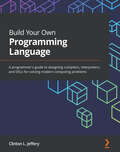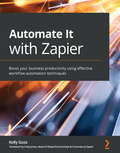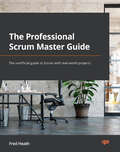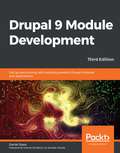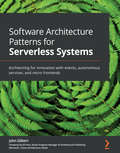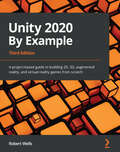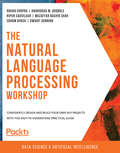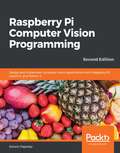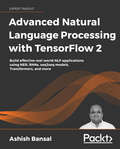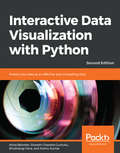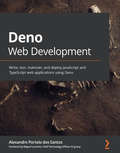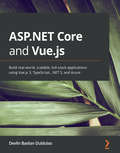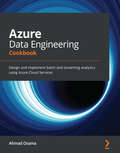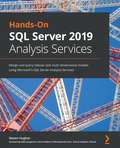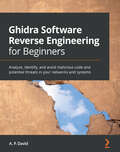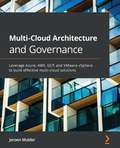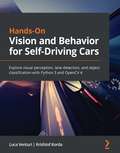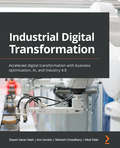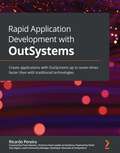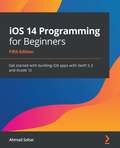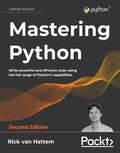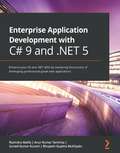- Table View
- List View
Build Your Own Programming Language: A programmer's guide to designing compilers, interpreters, and DSLs for solving modern computing problems
by Clinton L. JefferyWritten by the creator of the Unicon programming language, this book will show you how to implement programming languages to reduce the time and cost of creating applications for new or specialized areas of computingKey FeaturesReduce development time and solve pain points in your application domain by building a custom programming languageLearn how to create parsers, code generators, file readers, analyzers, and interpretersCreate an alternative to frameworks and libraries to solve domain-specific problemsBook DescriptionThe need for different types of computer languages is growing rapidly and developers prefer creating domain-specific languages for solving specific application domain problems. Building your own programming language has its advantages. It can be your antidote to the ever-increasing size and complexity of software.In this book, you'll start with implementing the frontend of a compiler for your language, including a lexical analyzer and parser. The book covers a series of traversals of syntax trees, culminating with code generation for a bytecode virtual machine. Moving ahead, you'll learn how domain-specific language features are often best represented by operators and functions that are built into the language, rather than library functions. We'll conclude with how to implement garbage collection, including reference counting and mark-and-sweep garbage collection. Throughout the book, Dr. Jeffery weaves in his experience of building the Unicon programming language to give better context to the concepts where relevant examples are provided in both Unicon and Java so that you can follow the code of your choice of either a very high-level language with advanced features, or a mainstream language.By the end of this book, you'll be able to build and deploy your own domain-specific languages, capable of compiling and running programs.What you will learnPerform requirements analysis for the new language and design language syntax and semanticsWrite lexical and context-free grammar rules for common expressions and control structuresDevelop a scanner that reads source code and generate a parser that checks syntaxBuild key data structures in a compiler and use your compiler to build a syntax-coloring code editorImplement a bytecode interpreter and run bytecode generated by your compilerWrite tree traversals that insert information into the syntax treeImplement garbage collection in your languageWho this book is forThis book is for software developers interested in the idea of inventing their own language or developing a domain-specific language. Computer science students taking compiler construction courses will also find this book highly useful as a practical guide to language implementation to supplement more theoretical textbooks. Intermediate-level knowledge and experience working with a high-level language such as Java or the C++ language are expected to help you get the most out of this book.
Automate It with Zapier: Boost your business productivity using effective workflow automation techniques
by Kelly Goss Cody JonesBuild easy and accessible solutions for automating mundane processes in marketing, sales, operations, and finance to enable teams to focus on core tasksKey FeaturesLearn Zapier and find solutions to specific problems with this comprehensive yet concise guideExplore various scenarios describing specific business problems and how they can be solved with ZapierDiscover expert tips and practical examples to harness the full potential of ZapierBook DescriptionZapier is an emerging no-code workflow automation technology that enables organizations to connect their cloud-based and web applications and automate data transfer between them. Zapier's built-in features and flexibility allow users to integrate thousands of business applications and create simple to complex automation to reduce time spent on repetitive tasks, thereby increasing productivity. This book is a must-have for business owners, their employees, and independent freelancers and contractors looking to use Zapier for business process automation. The book takes a hands-on approach to implementation and associated problem-solving methodologies that will have you up-and-running and productive in no time while leveling up your automation skills. You'll discover how to plan your automation building for optimal results, what are the native features available in Zapier, and the applications that connect with it, as well as how to optimally configure your workflows to automate your processes in as few steps as possible. Finally, you'll find out how to create advanced workflow automation from scratch and learn how to troubleshoot issues. By the end of this Zapier book, you'll be able to build your own advanced workflow automation using Zapier, addressing the key pain points encountered in businesses with manual and repetitive tasks.What you will learnThink creatively to plan your business workflows to overcome specific business problemsGet to grips with the native features and built-in applications available in ZapierExplore different types of third-party business applications that integrate with ZapierConfigure your workflows optimally to automate business processes and minimize task usageUse Zapier's library of pre-built workflows and create advanced workflows from scratchDiscover the extensive functionality and practical uses of Zapier's built-in appsWho this book is forThis book is for solutions architects, process consultants, business analysts, virtual assistants, digital marketers, CRM consultants, online business managers, technical consultants, bookkeepers, and accountants who want to deploy effective automation techniques in Zapier. This book will help micro, small, or medium-sized businesses to increase their productivity using workflow automation with Zapier, as well as freelancers and contractors providing digital process improvement, systemizing, and automation services. No prior experience with business process automation or Zapier is required.
The Professional Scrum Master (PSM I) Guide: Successfully practice Scrum with real-world projects and achieve your PSM I certification with confidence
by Fred HeathGo from absolute beginner to passing your PSM I exam first time with this comprehensive guide. Packed with practical examples, this book is updated for the latest Scrum guidelines to turn you into a Scrum Master!Key FeaturesGo from absolute beginner to exam-ready with detailed explorations of Scrum use-casesUnderstand the different applications of agile concepts, and how to best apply them to your businessDiscover expert tips and work with real-world examples to pass the PSM I certification exam first timeBook DescriptionEver wondered why you'd use Scrum over other process frameworks? Or what makes Agile just so agile? Or why you should bother with the PSM certification? This book has you covered.The Professional Scrum Master (PSM I) Guide is a comprehensive tutorial that will not only introduce you to the basics of Scrum, but build you up to be ready to pass your PSM I exam first time round. Where other books avoid detail, this guide provides you with detailed practical examples to take you from being an apprentice to becoming a master.Assuming you're a total beginner, this book will introduce you to Scrum methodologies with detailed use cases, teaching you the secrets of Scrum in such a way that you'll be well-equipped for the PSM I exam.This book demonstrates the real-world applications of Scrum in a variety of scenarios, all with practical examples.You'll understand why the structure of your Scrum team matters, what you can achieve with properly planned sprints, and how to create and manage sprint and product backlogs. The chapters are regularly concluded with quizzes relevant to the exam, reinforcing the values you learn on your journey. Finally, it concludes with some exam preparation and myth-dispelling to make sure you have an edge when it comes to earning your certificate. This is a guide that'll ensure you won't fall behind in an ever increasingly agile world.What you will learnGet to grips with Agile development and Scrum from the ground upUnderstand the roles and responsibilities within the Scrum teamDiscover how to conduct Scrum events and create Scrum artifactsExplore real-world scenarios and use cases for Scrum in actionDevelop an in-depth understanding of how to run a successful sprint to deliver results quicklyBe fully prepared and able to pass your PSM I exam first timeWho this book is forAssuming no prior knowledge of Scrum, this book is for professionals who want to build a strong foundation in Scrum practices with the intention of passing the PSM I exam. If you're a product owner or project manager looking to stay relevant in an agile world, this book is essential to helping you become a Scrum Master.
The Professional Scrum Master Guide: The unofficial guide to Scrum with real-world projects
by Fred HeathGo from absolute beginner to passing your exam the first time with this comprehensive guide. Filled with real-world illustrations, this book has been revised to align with the most recent Scrum standards, empowering you to become a Scrum Expert! A new, expanded second edition is now available, featuring the latest Scrum insights and enhanced exam preparation resources.Key FeaturesGo from absolute beginner to exam-ready with detailed explorations of Scrum use-casesUnderstand the different applications of agile concepts, and how to best apply them to your businessDiscover expert tips and work with real-world examples to pass the certification exam the first timeBook DescriptionThis book demonstrates the real-world applications of Scrum in a variety of scenarios, all with practical examples. You’ll understand why the structure of your Scrum team matters, and how to create and manage sprint and product backlogs. Each chapter concludes with relevance to the exam, reinforcing what you’ve learned as you work through the book and making sure you have an edge when it comes to earning your certificate. The statements made and opinions expressed herein belong exclusively to Packt Publishing Ltd and are not shared by or represent the viewpoint of Scrum.org. This training does not constitute an endorsement of any product, service or point of view. Scrum.org makes no representations, warranties or assurances of any kind, express or implied, as to the completeness, accuracy, reliability, suitability, availability or currency of the content contained in this presentation or any material related to this presentation. In no event shall Scrum.org, its agents, officers, employees, licensees or affiliates be liable for any damages whatsoever (including, without limitation, damages for loss of profits, business information, or loss of information) arising out of the information or statements contained in the training. Any reliance you place on such content is strictly at your own risk.What you will learnGet to grips with Agile development and Scrum from the ground upUnderstand the roles and responsibilities within the Scrum teamDiscover how to conduct Scrum events and create Scrum artifactsExplore real-world scenarios and use cases for Scrum in actionDevelop an in-depth understanding of how to run a successful sprint to deliver results quicklyBe fully prepared and able to pass your exam the first timeWho this book is forAssuming no prior knowledge of Scrum, this book is for professionals who want to build a strong foundation in Scrum practices with the intention of passing the certification exam. If you're a product owner or project manager looking to stay relevant in an agile world, this book is essential to helping you become a Scrum expert.
Drupal 9 Module Development: Get up and running with building powerful Drupal modules and applications, 3rd Edition
by Daniel Sipos Antonio De MarcoBuild and extend flexible Drupal sites and applications with this up-to-date, expert guide to Drupal 9 module development Key Features Explore the essential Drupal 9 APIs for module development Learn how to implement data modeling, caching, architecture, and much more in your Drupal applications Discover what's new in the latest Drupal core releases Book Description With its latest release, Drupal 9, the popular open source CMS platform has been updated with new functionalities for building complex Drupal apps with ease. This third edition of the Drupal Module Development guide covers these new Drupal features, helping you to stay on top of code deprecations and the changing architecture with every release. The book starts by introducing you to the Drupal 9 architecture and its subsystems before showing you how to create your first module with basic functionality. You'll explore the Drupal logging and mailing systems, learn how to output data using the theme layer, and work with menus and links programmatically. Once you've understood the different kinds of data storage, this Drupal guide will demonstrate how to create custom entities and field types and leverage the Database API for lower-level database queries. You'll also learn how to introduce JavaScript into your module, work with various file systems, and ensure that your code works on multilingual sites. Finally, you'll work with Views, create automated tests for your functionality, and write secure code. By the end of the book, you'll have learned how to develop custom modules that can provide solutions to complex business problems, and who knows, maybe you'll even contribute to the Drupal community! What you will learn Develop custom Drupal 9 modules for your applications Master different Drupal 9 subsystems and APIs Model, store, manipulate, and process data for effective data management Display data and content in a clean and secure way using the theme system Test your business logic to prevent regression Stay ahead of the curve and write PHP code by implementing best practices Who this book is for If you are a Drupal developer looking to learn Drupal 9 to write modules for your sites, this book is for you. Drupal site builders and PHP developers with basic object-oriented programming skills will also find this book helpful. Although not necessary, some Symfony experience will help with understanding concepts easily.
Software Architecture Patterns for Serverless Systems: Architecting for innovation with events, autonomous services, and micro frontends
by John GilbertA professional's guide to solving complex problems while designing modern softwareKey FeaturesLearn best practices for designing enterprise-grade software systemsUnderstand the importance of building reliable, maintainable, and scalable systemsBecome a professional software architect by learning the most effective software design patterns and architectural conceptsBook DescriptionAs businesses are undergoing a digital transformation to keep up with competition, it is now more important than ever for IT professionals to design systems to keep up with the rate of change while maintaining stability. This book takes you through the architectural patterns that power enterprise-grade software systems and the key architectural elements that enable change such as events, autonomous services, and micro frontends, along with demonstrating how to implement and operate anti-fragile systems. You'll divide up a system and define boundaries so that teams can work autonomously and accelerate the pace of innovation. The book also covers low-level event and data patterns that support the entire architecture, while getting you up and running with the different autonomous service design patterns. As you progress, you'll focus on best practices for security, reliability, testability, observability, and performance. Finally, the book combines all that you've learned, explaining the methodologies of continuous experimentation, deployment, and delivery before providing you with some final thoughts on how to start making progress. By the end of this book, you'll be able to architect your own event-driven, serverless systems that are ready to adapt and change so that you can deliver value at the pace needed by your business.What you will learnExplore architectural patterns to create anti-fragile systems that thrive with changeFocus on DevOps practices that empower self-sufficient, full-stack teamsBuild enterprise-scale serverless systemsApply microservices principles to the frontendDiscover how SOLID principles apply to software and database architectureCreate event stream processors that power the event sourcing and CQRS patternDeploy a multi-regional system, including regional health checks, latency-based routing, and replicationExplore the Strangler pattern for migrating legacy systems Who this book is forThis book is for software architects and aspiring software architects who want to learn about different patterns and best practices to design better software. Intermediate-level experience in software development and design is required. Beginner-level knowledge of the cloud will also help you get the most out of this software design book.
Unity 2020 By Example - Third Edition: A project-based guide to building 2D, 3D, augmented reality, and virtual reality games from scratch, 3rd Edition
by Robert WellsIf you are a game developer or programmer new to Unity and want to get up and running with the game engine in a hands-on way, this book is for you. Unity developers looking to work on practical projects to explore new features in Unity 2020 will find this book useful. A basic understanding of C# programming is required.
Unity 2020 By Example: A project-based guide to building 2D, 3D, augmented reality, and virtual reality games from scratch
by Robert WellsLearn Unity game development with C# through a series of practical projects ranging from building a simple 2D game to adding AR/VR experiences and machine learning capabilities in a simple yet effective wayKey FeaturesGain a high-level overview of the Unity game engine while building your own games portfolioDiscover best practices for implementing game animation, game physics, shaders, and effectsCreate fully featured apps, including Space shooter and a 2D adventure game, and develop AR/VR experiences and Game AI agentsBook DescriptionThe Unity game engine, used by millions of developers around the world, is popular thanks to its features that enable you to create games and 3D apps for desktop and mobile platforms in no time. With Unity 2020, this state-of-the-art game engine introduces enhancements in Unity tooling, editor, and workflow, among many other additions. The third edition of this Unity book is updated to the new features in Unity 2020 and modern game development practices. Once you’ve quickly got to grips with the fundamentals of Unity game development, you’ll create a collection, a twin-stick shooter, and a 2D adventure game. You’ll then explore advanced topics such as machine learning, virtual reality, and augmented reality by building complete projects using the latest game tool kit. As you implement concepts in practice, this book will ensure that you come away with a clear understanding of Unity game development. By the end of the book, you'll have a firm foundation in Unity development using C#, which can be applied to other engines and programming languages. You'll also be able to create several real-world projects to add to your professional game development portfolio.What you will learnLearn the fundamentals of game development, including GameObjects, components, and scenesDevelop a variety of games in C# and explore the brand new sprite shaping tool for Unity 3D and 2D gamesHandle player controls and input functionality for your Unity gamesImplement AI techniques such as pathfinding, finite state machines, and machine learning using Unity ML-AgentsCreate virtual and augmented reality games using UnityVR and AR FoundationExplore the cutting-edge features of Unity 2020 and how they can be used to improve your gamesWho this book is forIf you are a game developer or programmer new to Unity and want to get up and running with the game engine in a hands-on way, this book is for you. Unity developers looking to work on practical projects to explore new features in Unity 2020 will find this book useful. A basic understanding of C# programming is required.
The Natural Language Processing Workshop: Confidently design and build your own NLP projects with this easy-to-understand practical guide
by Dwight Gunning Rohan Chopra Sohom Ghosh Nipun Sadvilkar Aniruddha M. Godbole Muzaffar Bashir ShahMake NLP easy by building chatbots and models, and executing various NLP tasks to gain data-driven insights from raw text dataKey FeaturesGet familiar with key natural language processing (NLP) concepts and terminologyExplore the functionalities and features of popular NLP toolsLearn how to use Python programming and third-party libraries to perform NLP tasksBook DescriptionDo you want to learn how to communicate with computer systems using Natural Language Processing (NLP) techniques, or make a machine understand human sentiments? Do you want to build applications like Siri, Alexa, or chatbots, even if you've never done it before?With The Natural Language Processing Workshop, you can expect to make consistent progress as a beginner, and get up to speed in an interactive way, with the help of hands-on activities and fun exercises.The book starts with an introduction to NLP. You'll study different approaches to NLP tasks, and perform exercises in Python to understand the process of preparing datasets for NLP models. Next, you'll use advanced NLP algorithms and visualization techniques to collect datasets from open websites, and to summarize and generate random text from a document. In the final chapters, you'll use NLP to create a chatbot that detects positive or negative sentiment in text documents such as movie reviews.By the end of this book, you'll be equipped with the essential NLP tools and techniques you need to solve common business problems that involve processing text.What you will learnObtain, verify, clean and transform text data into a correct format for useUse methods such as tokenization and stemming for text extractionDevelop a classifier to classify comments in Wikipedia articlesCollect data from open websites with the help of web scrapingTrain a model to detect topics in a set of documents using topic modelingDiscover techniques to represent text as word and document vectorsWho this book is forThis book is for beginner to mid-level data scientists, machine learning developers, and NLP enthusiasts. A basic understanding of machine learning and NLP is required to help you grasp the topics in this workshop more quickly.
Raspberry Pi Computer Vision Programming: Design and implement computer vision applications with Raspberry Pi, OpenCV, and Python 3, 2nd Edition
by Ashwin PajankarPerform a wide variety of computer vision tasks such as image processing and manipulation, feature and object detection, and image restoration to build real-life computer vision applications Key Features Explore the potential of computer vision with Raspberry Pi and Python programming Perform computer vision tasks such as image processing and manipulation using OpenCV and Raspberry Pi Discover easy-to-follow examples and screenshots to implement popular computer vision techniques and applications Book Description Raspberry Pi is one of the popular single-board computers of our generation. All the major image processing and computer vision algorithms and operations can be implemented easily with OpenCV on Raspberry Pi. This updated second edition is packed with cutting-edge examples and new topics, and covers the latest versions of key technologies such as Python 3, Raspberry Pi, and OpenCV. This book will equip you with the skills required to successfully design and implement your own OpenCV, Raspberry Pi, and Python-based computer vision projects. At the start, you'll learn the basics of Python 3, and the fundamentals of single-board computers and NumPy. Next, you'll discover how to install OpenCV 4 for Python 3 on Raspberry Pi, before covering major techniques and algorithms in image processing, manipulation, and computer vision. By working through the steps in each chapter, you'll understand essential OpenCV features. Later sections will take you through creating graphical user interface (GUI) apps with GPIO and OpenCV. You'll also learn to use the new computer vision library, Mahotas, to perform various image processing operations. Finally, you'll explore the Jupyter Notebook and how to set up a Windows computer and Ubuntu for computer vision. By the end of this book, you'll be able to confidently build and deploy computer vision apps. What you will learn Set up a Raspberry Pi for computer vision applications Perform basic image processing with libraries such as NumPy, Matplotlib, and OpenCV Demonstrate arithmetical, logical, and other operations on images Work with a USB webcam and the Raspberry Pi Camera Module Implement low-pass and high-pass filters and understand their applications in image processing Cover advanced techniques such as histogram equalization and morphological transformations Create GUI apps with Python 3 and OpenCV Perform machine learning with K-means clustering and image quantization Who this book is for This book is for beginners as well as experienced Raspberry Pi and Python 3 enthusiasts who are looking to explore the amazing world of computer vision. Working knowledge of the Python 3 programming language is assumed.
Advanced Natural Language Processing with TensorFlow 2: Build effective real-world NLP applications using NER, RNNs, seq2seq models, Transformers, and more
by Ashish BansalOne-stop solution for NLP practitioners, ML developers, and data scientists to build effective NLP systems that can perform real-world complicated tasksKey FeaturesApply deep learning algorithms and techniques such as BiLSTMS, CRFs, BPE and more using TensorFlow 2Explore applications like text generation, summarization, weakly supervised labelling and moreRead cutting edge material with seminal papers provided in the GitHub repository with full working codeBook DescriptionRecently, there have been tremendous advances in NLP, and we are now moving from research labs into practical applications. This book comes with a perfect blend of both the theoretical and practical aspects of trending and complex NLP techniques.The book is focused on innovative applications in the field of NLP, language generation, and dialogue systems. It helps you apply the concepts of pre-processing text using techniques such as tokenization, parts of speech tagging, and lemmatization using popular libraries such as Stanford NLP and SpaCy. You will build Named Entity Recognition (NER) from scratch using Conditional Random Fields and Viterbi Decoding on top of RNNs.The book covers key emerging areas such as generating text for use in sentence completion and text summarization, bridging images and text by generating captions for images, and managing dialogue aspects of chatbots. You will learn how to apply transfer learning and fine-tuning using TensorFlow 2.Further, it covers practical techniques that can simplify the labelling of textual data. The book also has a working code that is adaptable to your use cases for each tech piece.By the end of the book, you will have an advanced knowledge of the tools, techniques and deep learning architecture used to solve complex NLP problems.What you will learnGrasp important pre-steps in building NLP applications like POS taggingUse transfer and weakly supervised learning using libraries like SnorkelDo sentiment analysis using BERTApply encoder-decoder NN architectures and beam search for summarizing textsUse Transformer models with attention to bring images and text togetherBuild apps that generate captions and answer questions about images using custom TransformersUse advanced TensorFlow techniques like learning rate annealing, custom layers, and custom loss functions to build the latest DeepNLP modelsWho this book is forThis is not an introductory book and assumes the reader is familiar with basics of NLP and has fundamental Python skills, as well as basic knowledge of machine learning and undergraduate-level calculus and linear algebra.The readers who can benefit the most from this book include intermediate ML developers who are familiar with the basics of supervised learning and deep learning techniques and professionals who already use TensorFlow/Python for purposes such as data science, ML, research, analysis, etc.
Interactive Data Visualization with Python: Present your data as an effective and compelling story, 2nd Edition
by Shubhangi Hora Abha Belorkar Anshu Kumar Sharath Chandra GuntukuCreate your own clear and impactful interactive data visualizations with the powerful data visualization libraries of Python Key Features Study and use Python interactive libraries, such as Bokeh and Plotly Explore different visualization principles and understand when to use which one Create interactive data visualizations with real-world data Book Description With so much data being continuously generated, developers, who can present data as impactful and interesting visualizations, are always in demand. Interactive Data Visualization with Python sharpens your data exploration skills, tells you everything there is to know about interactive data visualization in Python. You'll begin by learning how to draw various plots with Matplotlib and Seaborn, the non-interactive data visualization libraries. You'll study different types of visualizations, compare them, and find out how to select a particular type of visualization to suit your requirements. After you get a hang of the various non-interactive visualization libraries, you'll learn the principles of intuitive and persuasive data visualization, and use Bokeh and Plotly to transform your visuals into strong stories. You'll also gain insight into how interactive data and model visualization can optimize the performance of a regression model. By the end of the course, you'll have a new skill set that'll make you the go-to person for transforming data visualizations into engaging and interesting stories. What you will learn Explore and apply different interactive data visualization techniques Manipulate plotting parameters and styles to create appealing plots Customize data visualization for different audiences Design data visualizations using interactive libraries Use Matplotlib, Seaborn, Altair and Bokeh for drawing appealing plots Customize data visualization for different scenarios Who this book is for This book intends to provide a solid training ground for Python developers, data analysts and data scientists to enable them to present critical data insights in a way that best captures the user's attention and imagination. It serves as a simple step-by-step guide that demonstrates the different types and components of visualization, the principles, and techniques of effective interactivity, as well as common pitfalls to avoid when creating interactive data visualizations. Students should have an intermediate level of competency in writing Python code, as well as some familiarity with using libraries such as pandas.
Getting started with Deno
by Alexandre SantosServer-side web development with Deno made easyKey FeaturesGet to grips with the essential concepts and techniques relating to DenoLearn how to use Deno in real-world scenariosDevelop, test and deploy web applications and tools using DenoBook DescriptionDeno is a modern and secure JavaScript and TypeScript runtime that evolved from Node.js. It leverages the features of modern JavaScript, adding a secure by default layer and shipping the complete toolset in the runtime binary.Getting Started with Deno will introduce Deno’s primitives and explain how you can use them to build real-world applications. The book starts by explaining the importance of Deno. You’ll explore Node.js, understanding its benefits and why its release took the world by storm. The chapters then go on to explain the purpose Deno serves in today’s world, including the need for security models and decentralized dependency management, neither of which exist in Node. Later, you’ll gain insights into Deno’s ecosystem and toolchain. In addition to this, you’ll get up to speed with writing simple CLI applications, while also exploring Deno APIs and standard modules. Toward the concluding chapters, you’ll be guided through the process of building a complete API with Deno.By the end of this Deno book, you’ll have learned how to use Deno to create and maintain secure and reliable applications.What you will learnUnderstand why you should use DenoGet to grips with tooling and the Deno ecosystemLeverage the standard library and Deno’s security modelExplore common practices and web frameworks to build a REST API in DenoImplement real-world functionalities in Deno through a step-by-step processUse dependency injection and inversion of control (IoC), along with exploring application architecture practicesTest and deploy a Deno application in isolation using DockerWho This Book Is ForThis book is for developers who want to leverage their JavaScript and TypeScript skills in a secure, simple, and modern runtime, using them for web application development. Although prior knowledge of Node.js is not necessary, it is recommended to easily get started with learning web development with Deno.Table of ContentsWhat is DenoThe toolchainRuntime and standard-libraryBuilding your first web applicationAdding Users and Migrating to OakAdding Authentication and Connecting to the DatabaseHTTPS, extracting configuration, and Deno oin the browserTesting - Unit and Integration Deploying a Deno applicationWrapping up
ASP.NET Core and Vue.js: Build real-world, scalable, full-stack applications using Vue.js 3, TypeScript, .NET 5, and Azure
by Devlin Basilan DuldulaoA guide to building enterprise, cloud-ready full-stack web applications using TypeScript, Vue.js 3, and ASP.NET Core 5 for busy developersKey FeaturesLearn how to implement clean architecture in the latest ASP.NET Core 5 Web APIDevelop Vue.js 3 single-page applications (SPAs) using TypeScript or JavaScript programming and Vuex state managementSecure, test, and deploy your full-stack web application to Azure CloudBook DescriptionVue.js 3 is faster and smaller than the previous version, and TypeScript's full support out of the box makes it a more maintainable and easier-to-use version of Vue.js. Then, there's ASP.NET Core 5, which is the fastest .NET web framework today. Together, Vue.js for the frontend and ASP.NET Core 5 for the backend make a powerful combination. This book follows a hands-on approach to implementing practical methodologies for building robust applications using ASP.NET Core 5 and Vue.js 3. The topics here are not deep dive and the book is intended for busy .NET developers who have limited time and want a quick implementation of a clean architecture with popular libraries. You'll start by setting up your web app's backend, guided by clean architecture, command query responsibility segregation (CQRS), mediator pattern, and Entity Framework Core 5. The book then shows you how to build the frontend application using best practices, state management with Vuex, Vuetify UI component libraries, Vuelidate for input validations, lazy loading with Vue Router, and JWT authentication. Later, you'll focus on testing and deployment. All the tutorials in this book support Windows 10, macOS, and Linux users. By the end of this book, you'll be able to build an enterprise full-stack web app, use the most common npm packages for Vue.js and NuGet packages for ASP.NET Core, and deploy Vue.js and ASP.NET Core to Azure App Service using GitHub Actions.What you will learnDiscover CQRS and mediator pattern in the ASP.NET Core 5 Web APIUse Serilog, MediatR, FluentValidation, and Redis in ASP.NETExplore common Vue.js packages such as Vuelidate, Vuetify, and VuexManage complex app states using the Vuex state management libraryWrite integration tests in ASP.NET Core using xUnit and FluentAssertionsDeploy your app to Microsoft Azure using the new GitHub Actions for continuous integration and continuous deployment (CI/CD)Who this book is forThis app development book is for .NET developers who want to get started with Vue.js and build full-stack real-world enterprise web applications. Developers looking to build a proof-of-concept application quickly and pragmatically using their existing knowledge of ASP.NET Core as well as developers who want to write readable and maintainable code using TypeScript and the C# programming language will also find this book useful. The book assumes intermediate-level .NET knowledge along with an understanding of C# programming, JavaScript, and ECMAScript.
Rapid Application Development with AWS Amplify: Build cloud-native mobile and web apps from scratch through continuous delivery and test automation
by Adrian LeungGet to grips with the AWS Amplify framework and use it to build scalable cloud-native progressive web apps with React and cross-platform mobile apps with React Native in TypeScriptKey FeaturesExplore the capabilities of AWS Amplify with popular app frameworks for both web and mobile app platformsBuild your first cloud-native web and mobile applications using AWS AmplifyLeverage AWS Amplify to design GraphQL APIs for your web and mobile applicationsBook DescriptionAWS Amplify is a modern toolkit that includes a command line interface (CLI); libraries for JS, iOS, and Android programming; UI component libraries for frameworks like React, Angular, and Vue.js for web development, and React Native and Flutter for mobile development. You'll begin by learning how to build AWS Amplify solutions with React and React Native with TypeScript from scratch, along with integrating it with existing solutions. This book will show you the fastest way to build a production-ready minimum viable product (MVP) within days instead of years. You'll also discover how to increase development speed without compromising on quality by adopting behavior-driven development (BDD) and Cypress for end-to-end test automation, as well as the Amplify build pipeline (DevOps or CI/CD pipeline) to ensure optimal quality throughout continuous test automation and continuous delivery. As you advance, you'll work with React to determine how to build progressive web apps (PWAs) with Amplify and React Native for cross-platform mobile apps. In addition to this, you'll find out how to set up a custom domain name for your new website and set up the AWS Amplify Admin UI for managing the content of your app effectively. By the end of this AWS book, you'll be able to build a full-stack AWS Amplify solution all by yourself.What you will learnBuild React and React Native apps with Amplify and TypeScriptExplore pre-built Amplify UI components for rapid prototypingAdd user management with Amplify authentication to your appUse Amplify GraphQL to create a blog postDiscover how to upload photos to Amplify StorageEnable DevOps with the Amplify pipeline for your appGet to grips with BDD and test automation with Cypress and CucumberSet up a custom domain name for your website and manage app content with the Amplify Admin UIWho this book is forThis book is for developers and tech companies looking to develop cloud-native products rapidly with the AWS ecosystem. Web and mobile developers with little-to-no experience in TypeScript programming will also find this book helpful. Although no prior experience with AWS or TypeScript is required, basic familiarity with modern frameworks such as React and React Native is useful.
Azure Data Engineering Cookbook: Design and implement batch and streaming analytics using Azure Cloud Services
by Ahmad OsamaOver 90 recipes to help data scientists and AI engineers orchestrate modern ETL/ELT workflows and perform analytics using Azure services more easilyKey FeaturesDiscover how to work with different SQL and NoSQL data stores in Microsoft AzureCreate and execute real-time processing solutions using Azure Databricks, Azure Stream Analytics, and Azure Data ExplorerDesign and execute batch processing solutions using Azure Data FactoryBook DescriptionData engineering is a growing field that focuses on preparing data for analysis. This book uses various Azure services to implement and maintain infrastructure to extract data from multiple sources, and then transform and load it for data analysis. This book takes you through different techniques for performing big data engineering using Microsoft cloud services. It begins by showing you how Azure Blob storage can be used for storing large amounts of unstructured data and how to use it for orchestrating a data workflow. You'll then work with different Cosmos DB APIs and Azure SQL Database. Moving on, you'll discover how to provision an Azure Synapse database and find out how to ingest and analyze data in Azure Synapse. As you advance, you'll cover the design and implementation of batch processing solutions using Azure Data Factory, and understand how to manage, maintain, and secure Azure Data Factory pipelines. You'll also design and implement batch processing solutions using Azure Databricks and then manage and secure Azure Databricks clusters and jobs. In the concluding chapters, you'll learn how to process streaming data using Azure Stream Analytics and Data Explorer. By the end of this Azure book, you'll have gained the knowledge you need to be able to orchestrate batch and real-time ETL workflows in Microsoft Azure.What you will learnUse Azure Blob storage for storing large amounts of unstructured dataPerform CRUD operations on the Cosmos Table APIImplement elastic pools and business continuity with Azure SQL DatabaseIngest and analyze data using Azure Synapse AnalyticsDevelop Data Factory data flows to extract data from multiple sourcesManage, maintain, and secure Azure Data Factory pipelinesProcess streaming data using Azure Stream Analytics and Data ExplorerWho this book is forThis book is for database administrators, database developers, and extract, load, transform (ETL) developers looking to build expertise in Azure Data engineering using a recipe-based approach. Technical architects and database architects with experience in designing data or ETL applications either on-premise or on any other cloud vendor who want to learn Azure Data engineering concepts will also find this book useful. Prior knowledge of Azure fundamentals and data engineering concepts is needed.
Hands-On SQL Server 2019 Analysis Services: Design and query tabular and multi-dimensional models using Microsoft's SQL Server Analysis Services
by Adam Jorgensen Steven HughesGet up to speed with the new features added to Microsoft SQL Server 2019 Analysis Services and create models to support your businessKey FeaturesExplore tips and tricks to design, develop, and optimize end-to-end data analytics solutions using Microsoft's technologiesLearn tabular modeling and multi-dimensional cube design development using real-world examplesImplement Analysis Services to help you make productive business decisionsBook DescriptionSQL Server Analysis Services (SSAS) continues to be a leading enterprise-scale toolset, enabling customers to deliver data and analytics across large datasets with great performance. This book will help you understand MS SQL Server 2019's new features and improvements, especially when it comes to SSAS.First, you'll cover a quick overview of SQL Server 2019, learn how to choose the right analytical model to use, and understand their key differences. You'll then explore how to create a multi-dimensional model with SSAS and expand on that model with MDX. Next, you'll create and deploy a tabular model using Microsoft Visual Studio and Management Studio. You'll learn when and how to use both tabular and multi-dimensional model types, how to deploy and configure your servers to support them, and design principles that are relevant to each model. The book comes packed with tips and tricks to build measures, optimize your design, and interact with models using Excel and Power BI. All this will help you visualize data to gain useful insights and make better decisions. Finally, you'll discover practices and tools for securing and maintaining your models once they are deployed.By the end of this MS SQL Server book, you'll be able to choose the right model and build and deploy it to support the analytical needs of your business.What you will learnDetermine the best analytical model using SSASCover the core aspects involved in MDX, including writing your first queryImplement calculated tables and calculation groups (new in version 2019) in DAXCreate and deploy tabular and multi-dimensional models on SQL 2019Connect and create data visualizations using Excel and Power BIImplement row-level and other data security methods with tabular and multi-dimensional modelsExplore essential concepts and techniques to scale, manage, and optimize your SSAS solutionsWho this book is forThis Microsoft SQL Server book is for BI professionals and data analysts who are looking for a practical guide to creating and maintaining tabular and multi-dimensional models using SQL Server 2019 Analysis Services. A basic working knowledge of BI solutions such as Power BI and database querying is required.
Ghidra Software Reverse Engineering for Beginners: Analyze, identify, and avoid malicious code and potential threats in your networks and systems
by A. P. DavidDetect potentials bugs in your code or program and develop your own tools using the Ghidra reverse engineering framework developed by the NSA projectKey FeaturesMake the most of Ghidra on different platforms such as Linux, Windows, and macOSLeverage a variety of plug-ins and extensions to perform disassembly, assembly, decompilation, and scriptingDiscover how you can meet your cybersecurity needs by creating custom patches and toolsBook DescriptionGhidra, an open source software reverse engineering (SRE) framework created by the NSA research directorate, enables users to analyze compiled code on any platform, whether Linux, Windows, or macOS. This book is a starting point for developers interested in leveraging Ghidra to create patches and extend tool capabilities to meet their cybersecurity needs.You'll begin by installing Ghidra and exploring its features, and gradually learn how to automate reverse engineering tasks using Ghidra plug-ins. You'll then see how to set up an environment to perform malware analysis using Ghidra and how to use it in the headless mode. As you progress, you'll use Ghidra scripting to automate the task of identifying vulnerabilities in executable binaries. The book also covers advanced topics such as developing Ghidra plug-ins, developing your own GUI, incorporating new process architectures if needed, and contributing to the Ghidra project.By the end of this Ghidra book, you'll have developed the skills you need to harness the power of Ghidra for analyzing and avoiding potential vulnerabilities in code and networks.What you will learnGet to grips with using Ghidra's features, plug-ins, and extensionsUnderstand how you can contribute to GhidraFocus on reverse engineering malware and perform binary auditingAutomate reverse engineering tasks with Ghidra plug-insBecome well-versed with developing your own Ghidra extensions, scripts, and featuresAutomate the task of looking for vulnerabilities in executable binaries using Ghidra scriptingFind out how to use Ghidra in the headless modeWho this book is forThis SRE book is for developers, software engineers, or any IT professional with some understanding of cybersecurity essentials. Prior knowledge of Java or Python, along with experience in programming or developing applications, is required before getting started with this book.
Multi-Cloud Architecture and Governance: Leverage Azure, AWS, GCP, and VMware vSphere to build effective multi-cloud solutions
by Jeroen MulderA comprehensive guide to architecting, managing, implementing, and controlling multi-cloud environmentsKey FeaturesDeliver robust multi-cloud environments and improve your business productivityStay in control of the cost, governance, development, security, and continuous improvement of your multi-cloud solutionIntegrate different solutions, principles, and practices into one multi-cloud foundationBook DescriptionMulti-cloud has emerged as one of the top cloud computing trends, with businesses wanting to reduce their reliance on only one vendor. But when organizations shift to multiple cloud services without a clear strategy, they may face certain difficulties, in terms of how to stay in control, how to keep all the different components secure, and how to execute the cross-cloud development of applications. This book combines best practices from different cloud adoption frameworks to help you find solutions to these problems.With step-by-step explanations of essential concepts and practical examples, you'll begin by planning the foundation, creating the architecture, designing the governance model, and implementing tools, processes, and technologies to manage multi-cloud environments. You'll then discover how to design workload environments using different cloud propositions, understand how to optimize the use of these cloud technologies, and automate and monitor the environments. As you advance, you'll delve into multi-cloud governance, defining clear demarcation models and management processes. Finally, you'll learn about managing identities in multi-cloud: who's doing what, why, when, and whereBy the end of this book, you'll be able to create, implement, and manage multi-cloud architectures with confidenceWhat you will learnGet to grips with the core functions of multiple cloud platformsDeploy, automate, and secure different cloud solutionsDesign network strategy and get to grips with identity and access management for multi-cloudDesign a landing zone spanning multiple cloud platformsUse automation, monitoring, and management tools for multi-cloudUnderstand multi-cloud management with the principles of BaseOps, FinOps, SecOps, and DevOpsDefine multi-cloud security policies and use cloud security toolsTest, integrate, deploy, and release using multi-cloud CI/CD pipelinesWho this book is forThis book is for architects and lead engineers involved in architecting multi-cloud environments, with a focus on getting governance right to stay in control of developments in multi-cloud. Basic knowledge of different cloud platforms (Azure, AWS, GCP, VMWare, and OpenStack) and understanding of IT governance is necessary.
Hands-On Vision and Behavior for Self-Driving Cars: Explore visual perception, lane detection, and object classification with Python 3 and OpenCV 4
by Luca Venturi Krishtof KordaThis book is for software engineers who are interested in learning about technologies that drive the autonomous car revolution. Although basic knowledge of computer vision and Python programming is required, prior knowledge of advanced deep learning and how to use sensors (lidar) is not needed.
Industrial Digital Transformation: Accelerate digital transformation with business optimization, AI, and Industry 4.0
by Shyam Varan Nath Ann Dunkin Mahesh Chowdhary Nital PatelDelve into industrial digital transformation and learn how to implement modern business strategies powered by digital technologies as well as organization and cultural optimizationKey FeaturesIdentify potential industry disruptors from various business domains and emerging technologiesLeverage existing resources to identify new avenues for generating digital revenueBoost digital transformation with cloud computing, big data, artificial intelligence (AI), and the Internet of Things (IoT)Book DescriptionDigital transformation requires the ability to identify opportunities across industries and apply the right technologies and tools to achieve results. This book is divided into two parts with the first covering what digital transformation is and why it is important. The second part focuses on how digital transformation works.After an introduction to digital transformation, you will explore the transformation journey in logical steps and understand how to build business cases and create productivity benefit statements. Next, you'll delve into advanced topics relating to overcoming various challenges. Later, the book will take you through case studies in both private and public sector organizations. You'll explore private sector organizations such as industrial and hi-tech manufacturing in detail and get to grips with public sector organizations by learning how transformation can be achieved on a global scale and how the resident experience can be improved. In addition to this, you will understand the role of artificial intelligence, machine learning and deep learning in digital transformation. Finally, you'll discover how to create a playbook that can ensure success in digital transformation.By the end of this book, you'll be well-versed with industrial digital transformation and be able to apply your skills in the real world.What you will learnGet up to speed with digital transformation and its important aspectsExplore the skills that are needed to execute the transformationFocus on the concepts of Digital Thread and Digital TwinUnderstand how to leverage the ecosystem for successful transformationGet to grips with various case studies spanning industries in both private and public sectorsDiscover how to execute transformation at a global scaleFind out how AI delivers value in the transformation journeyWho this book is forThis book is for IT leaders, digital strategy leaders, line-of-business leaders, solution architects, and IT business partners looking for digital transformation opportunities within their organizations. Professionals from service and management consulting firms will also find this book useful. Basic knowledge of enterprise IT and some intermediate knowledge of identifying digital revenue streams or internal transformation opportunities are required to get started with this book.
Rapid Application Development with OutSystems: Create applications with OutSystems up to seven times faster than with traditional technologies
by Ricardo Pereira Paulo Moreira Taiji HaginoDiscover best practices to create simple, robust, and scalable software solutions quickly and securely, and focus on what's important - the business and the end customerKey FeaturesDiscover strategies and tips for low-code and no-code development with the help of useful examplesBuild enterprise-scale reactive web and mobile applicationsExplore the benefits of low-code developmentBook DescriptionOutSystems is a software development platform that speeds up the build phase by abstracting code and making almost everything visual. This means replacing textual language with visual artifacts that avoid lexical errors and speed up code composition using accelerators and predefined templates.The book begins by walking you through the fundamentals of the technology, along with a general overview of end-to-end web and mobile software development. You'll learn how to configure your personal area in the cloud and use the OutSystems IDE to connect with it. The book then shows you how to build a web application based on the best architectural and developmental practices in the market, and takes the same approach for the mobile paradigm. As you advance, you'll find out how to develop the same application, and the great potential of reusing code from one paradigm in another and the symbiosis between them is showcased.The only application that'll differ from the application in the exercise is the one used in business process technology (BPT), with a focus on a common market use case.By the end of this OutSystems book, you'll be able to develop enterprise-level applications on the web and mobile, integrating them with third parties and other systems on the market. You'll also understand the concepts of performance, security, and software construction and be able to apply them effectively.What you will learnGet to grips with the OutSystems infrastructureDevelop reactive web and mobile applications in OutSystems using best practices in Service StudioDefine and design Architecture Canvas (3-Layer Canvas) for your applicationsIntegrate with external systems in OutSystemsEnhance applications with BPTManage and monitor your applications in the OutSystems infrastructureWho this book is forThis book is for back-end developers, tech leaders, UX/UI developers, frontend developers, (in general, full-stack developers), tech companies, and enterprises looking to learn how to develop web and mobile software quickly and disruptively by leveraging OutSystems, one of the most low-code platforms in the market. An IT background is not mandatory; however, experience in SQL, JavaScript, HTML, CSS, and C# is required to get started with this book.
iOS 14 Programming for Beginners: Get started with building iOS apps with Swift 5.3 and Xcode 12, 5th Edition
by Ahmad SaharLearn iOS app development and work with the latest Apple development toolsKey FeaturesExplore the latest features of Xcode 12 and the Swift 5.3 programming language in this updated fifth editionKick-start your iOS programming career and have fun building your own iOS appsDiscover the new features of iOS 14 such as Mac Catalyst, SwiftUI, widgets and App ClipsBook DescriptionIf you're a beginner looking to work and experiment with powerful iOS 14 features such as widgets and App Clips to create your own apps, this iOS programming guide is for you. The book offers a comprehensive introduction for experienced programmers who are new to iOS, taking you through the entire process of learning the Swift language, writing your own apps, and publishing them on the App Store.Fully updated to cover the new iOS 14 features, along with Xcode 12 and Swift 5.3, this fifth edition of iOS 14 Programming for Beginners starts with an introduction to the Swift programming language and shows you how to accomplish common programming tasks with it. You'll then start building the user interface (UI) of a complete real-world app using the storyboards feature in the latest version of Xcode and implement the code for views, view controllers, data managers, and other aspects of mobile apps. The book will also help you apply iOS 14 features to existing apps and introduce you to SwiftUI, a new way to build apps for all Apple devices. Finally, you'll set up testers for your app and understand what you need to do to publish your app on the App Store.By the end of this book, you'll not only be well versed in writing and publishing applications, but you'll also be able to apply your iOS development skills to enhance existing apps.What you will learnGet to grips with the fundamentals of Xcode 12 and Swift 5.3, the building blocks of iOS developmentUnderstand how to prototype an app using storyboardsDiscover the Model-View-Controller design pattern and how to implement the desired functionality within an appImplement the latest iOS features, such as widgets and App ClipsConvert an existing iPad app into an Apple Silicon Mac appDesign, deploy, and test your iOS applications with design patterns and best practicesWho this book is forThis book is for anyone who has programming experience but is new to Swift and iOS app development. Experienced programmers looking to explore the latest iOS 14 features will also find this book useful.
Mastering Python: Write powerful and efficient code using the full range of Python's capabilities, 2nd Edition
by Rick van HattemUse advanced features of Python to write high-quality, readable code and packagesKey FeaturesExtensively updated for Python 3.10 with new chapters on design patterns, scientific programming, machine learning, and interactive PythonShape your scripts using key concepts like concurrency, performance optimization, asyncio, and multiprocessingLearn how advanced Python features fit together to produce maintainable codeBook DescriptionEven if you find writing Python code easy, writing code that is efficient, maintainable, and reusable is not so straightforward. Many of Python's capabilities are underutilized even by more experienced programmers. Mastering Python, Second Edition, is an authoritative guide to understanding advanced Python programming so you can write the highest quality code. This new edition has been extensively revised and updated with exercises, four new chapters and updates up to Python 3.10.Revisit important basics, including Pythonic style and syntax and functional programming. Avoid common mistakes made by programmers of all experience levels. Make smart decisions about the best testing and debugging tools to use, optimize your code's performance across multiple machines and Python versions, and deploy often-forgotten Python features to your advantage. Get fully up to speed with asyncio and stretch the language even further by accessing C functions with simple Python calls. Finally, turn your new-and-improved code into packages and share them with the wider Python community.If you are a Python programmer wanting to improve your code quality and readability, this Python book will make you confident in writing high-quality scripts and taking on bigger challengesWhat you will learnWrite beautiful Pythonic code and avoid common Python coding mistakesApply the power of decorators, generators, coroutines, and metaclassesUse different testing systems like pytest, unittest, and doctestTrack and optimize application performance for both memory and CPU usageDebug your applications with PDB, Werkzeug, and faulthandlerImprove your performance through asyncio, multiprocessing, and distributed computingExplore popular libraries like Dask, NumPy, SciPy, pandas, TensorFlow, and scikit-learnExtend Python's capabilities with C/C++ libraries and system callsWho this book is forThis book will benefit more experienced Python programmers who wish to upskill, serving as a reference for best practices and some of the more intricate Python techniques. Even if you have been using Python for years, chances are that you haven't yet encountered every topic discussed in this book. A good understanding of Python programming is necessary
Enterprise Application Development with C# 9 and .NET 5
by Ravindra AkellaIf you are a developer, architect, or senior programmer who wants to fully leverage the .NET Framework and C# language features and techniques to take your career to the next level, this book is for you. Basic to intermediate knowledge of .NET Framework or .NET Core and C# programming will help you to make the most out of this book.
